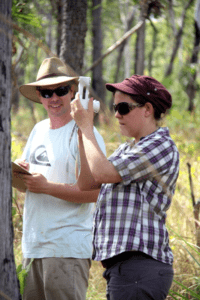Australia’s universities together have an enrolment of more than one million students, and employ more than 100,000 staff. University expenditure accounts for 1.6 per cent of GDP, with significant spillover benefits for students, staff, industry, and the wider community.[1] However, our higher education industry – Australia’s fourth-largest export earner in 2012[2] – faces immediate challenges associated with the rise of the internet, new requirements to make research data publicly available, and maintaining research leadership in nationally important fields such as ecosystem science. To remain competitive on this globally-levelled playing field, and thereby to continue to make significant social and economic contributions to Australia, our universities must find strategic ways to improve the quality, efficiency and cost-effectiveness of their research and education programs. Key challenges include:
- The increasing need to deliver better returns on public investment in research and education
- The need to make publicly-funded research data publicly accessible in a cost-effective manner
- The high cost and complexity of the research infrastructure required to efficiently address current issues in ecosystem science – like food security, clean air, land, and water – meaning that no university or institution can work effectively alone
By working closely with diverse partners and building on past efforts, TERN has transformed Australian ecosystem science from a situation in which effort was fragmented, inefficient and short-term, to one in which effort is national, networked and delivering for the future. The key challenges faced by the higher education and research industry have been addressed by:
- Enabling collaboration within and across universities and disciplines, reducing duplication of effort and value-adding to public investment by leveraging significant in-kind support
- Delivery of the data infrastructure required to enable consistent ecosystem data collection, storage, discovery, publishing, licensing and citation across the country, which is helping the higher education and research industry rapidly and efficiently realise the benefits of the global movement towards open data and data publishing
- Building or enhancing national networks of people and collaborative ecosystem science research infrastructure across 17 university partners, state and federal government agencies and initiatives, CSIRO and another 25+ organisations, now open to all users
TERN’s infrastructure is relevant to 95% of the 39 members of Universities Australia. Seventeen have been directly involved in TERN’s planning, construction and implementation. A further 13 have participated indirectly, and another seven stand to benefit from TERN’s infrastructure because they run undergraduate or postgraduate courses in ecosystem science. TERN’s infrastructure is becoming so recognised in an educational context that we were recently featured in an article in the highly prestigious international journal Nature alongside analogous organisations overseas.
“…the delivery of TERN’s nationally collaborative infrastructure is one of the most important developments in ecosystem sciences for decades. Supporting TERN is strategic for us as a higher education institution because it positions our students and researchers well to take advantage of new opportunities, maintaining our lead in these fields.” – Prof Ian Gentle, Associate Dean (Research) of the Faculty of Science, University of Queensland |
Our infrastructure and data products are being used by some of Australia’s most successful ecosystem scientists, spread across many universities and institutions. More than $3 million worth of the highly competitive ARC Discovery projects funded in the most recent 2013 round were reliant on components of the collaborative research infrastructure delivered through TERN. We’re only four years old, but already we’re struggling to keep up with demand.
| “[We] face ever-increasing equipment costs in the context of ever-greater competition for research funds, and an ever-growing volume and complexity of research data. One way that we as a university can work towards ensuring our researchers and students have access to the top-quality infrastructure they need to succeed is by supporting national collaborative research infrastructure capabilities such as TERN.” – Prof Bob Hill, Executive Dean of the Faculty of Sciences, University of Adelaide |
 |  | |
TERN enjoys strong support from 95% of Australia’s universities | Students of Charles Darwin University use the permanent transects at Litchfield Savanna SuperSite to develop their skills and collect ecological data that will be added to the site’s data compendium, thus aiding further research at the site. (Photo courtesy of Karen Joyce) |
[1] Universities Australia: https://www.universitiesaustralia.edu.au/australias-universities/Australias-Universities#.Ux6ryJyL-Ac
[2] DFAT report: http://www.dfat.gov.au/publications/stats-pubs/cot-cy-2012.pdf
Published in TERN newsletter April 2014






